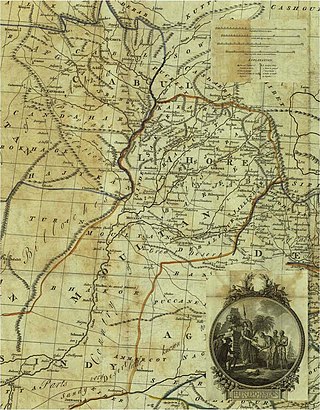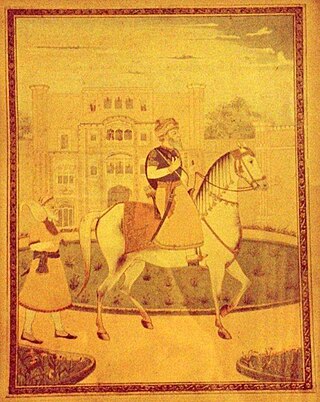
The Sukerchakia Misl was one of twelve Sikh misls in Punjab during the 18th century, concentrated in Gujranwala and Hafizabad districts in western Punjab and ruled from (1752–1801). The misl was founded by Charat Singh of Sandhawalia, grandfather of Maharaja Ranjit Singh. The last Sukerchakia Misldar was Maharaja Ranjit Singh. Towards the end of the eighteenth century, Maharaja Ranjit Singh united all the misls and established an independent Sikh Empire.

The Sikh Confederacy was the confederation of the twelve sovereign states. which rose during the 18th century in the Punjab region in the northern part of the Indian subcontinent and is cited as one of the causes of the weakening of the Mughal Empire prior to Nader Shah's invasion of India (1738–1740).

Jassa Singh Ramgarhia (1723–1803) was a prominent Sikh leader during the period of the Sikh Confederacy. He was the founder of the Ramgarhia Misl.

Sultan-ul-Qaum Sardar Jassa Singh Ahluwalia was a Sikh leader during the period of the Sikh Confederacy, being the Supreme Leader of the Dal Khalsa. He was also Misldar of the Ahluwalia Misl. This period was an interlude, lasting roughly from the time of the death of Banda Bahadur in 1716 to the founding of the Sikh Empire in 1801. He founded the Kapurthala State in 1772.
Sardar Hari Singh Dhillon was an 18th century Jat Sikh warrior and the chief of Bhangi Misl. During the formation of the Dal Khalsa he was acknowledged as leader of Taruna Dal, he was made chief of Bhangi Misl, the most powerful of all Misls.
Khushal Singh Virk was the second chief of Singhpuria Misl from 1753 to 1795, extending its territory on both sides of the Sutlej River. His 'acquired' lands included Jalandhar, Nurpur, Bahrampur, Patti and Bharatgarh. Jalandhar doab and adjoining areas yielded an annual income of three lakh rupees.

Sardar Charat Singh, also romanised as Charhat Singh, was the founder of Sukerchakia Misl and father of Mahan Singh, and the grandfather of Ranjit Singh. He distinguished himself at an early age in campaigns against Ahmad Shah Abdali and along with 150 horsemen split from the Singhpuria Misl to establish the Sukerchakia Misl.

The Afghan–Sikh wars spanned from 1748 to 1837 in the Indian subcontinent, and saw multiple phases of fighting between the Durrani Empire and the Sikh Empire, mainly in and around Punjab region. The conflict's origins stemmed from the days of the Dal Khalsa, and continued after the Emirate of Kabul succeeded the Durrani Empire.
The Battle of Kup was fought on 5 February 1762, between the Afghan forces of Ahmad Shah Durrani and the Sikhs, under the command of Jassa Singh Ahluwalia and Charat Singh. Ahmad Shah Durrani and the Afghan forces reached Malerkotla, west of Sirhind. Different sources give various estimates on how many sikhs were present. According to Tom Landsford, nearly 30,000 Sikh men, women, children, and elderly laid encamped. According to Narendra Sinha, 40,000 Sikhs were present. According to Hari Ram Gupta, 50,000 Sikh soldiers laid encamped at Kup while 5,000 non combatants laid encamped at Pind Garma. Abdali's forces outnumbered the Sikhs in hand-to-hand combat and the Sikhs couldn't use their usual tactics of hit and run, but had to engage in battle while protecting the civilians at the same time. With surprise attack, the Sikhs threw a human ring around civilians as protection and fought the battle killing several thousand Afghans. Abdali was able to break the ring and carried out a full scale massacre of the Sikh civilians. Ahmad Shah's forces killed several thousand Sikhs, and the surviving Sikhs fled to Barnala. According to various different estimates, as many as 5,000 to 30,000 Sikh men, women, elderly and children were killed in what is known as the second Sikh genocide.
The Battle of Gujranwala was fought between the Durrani Empire and the Sikh Confederacy in September 1761.

Ahmad Shah Durrani, the founder of the Durrani Empire, invaded Indian subcontinent for eight times between 1748 and 1767, following the collapse of Mughal Empire in the mid-18th century. His objectives were met through the raids and deepened the political crisis in India.
Ahmad Shah Durrani raided India for the fifth time in 1759, initiating a series of conflicts with the Marathas and Sikhs. The Pashtuns, preparing for armed struggle, quickly advanced into Punjab, capturing a Maratha garrison at Peshawar and later overrunning Attock. General Jahan Khan played a key role in the advance but was met with resistance from the Marathas and their Sikh allies, led by Sabaji Shinde and the armies of the Sukerchakia and Ahluwalia Misls. In a fierce battle, the combined forces of the Marathas and Sikhs defeated the Afghans, killing 2,000 and wounding Jahan Khan. Despite being outnumbered, Sabaji managed to defend Lahore and inflicted a severe defeat on Jahan Khan, who retreated to Peshawar. This defeat angered Ahmad Shah Durrani and prompted him to take action.
The Battle of Sirhind was fought between Durrani Empire and Sikh Misls on 14 January 1764.
The Battle of Harnaulgarh was fought between the Durrani Empire and the Sikh Misls of Dal Khalsa in 1762.

The Battle of Amritsar, also known as the Battle of Gohalwar, was fought between the Durrani Empire and Shaheedan Misl of the Dal Khalsa on 11 November 1757. Following the fourth invasion of Ahmad Shah Durrani, his army was attacked by Sikh bands under the command of Ala Singh and Baba Deep Singh. Following the attacks, Ahmad Shah desecrated the Sikh holy site known as the Shri Harmandir Sahib in Amritsar. The news of the desecration reached Baba Deep Singh who vowed to liberate the holy site from the Afghans. This resulted in a pitched battle being fought in the village of Gohalwar, near Amritsar. The battle resulted in Baba Deep Singh being killed and an Afghan victory.

The Battle of Delhi was fought between Khalsa Sikhs and the Mughal Empire in 1783.

Tara Singh Ghaiba was an associate member of the Dallewalia Misl, who became the Leader of the Misl after the death of their founding member and head Sardar Gulab Singh Khatri. He made Rahon the capital of his Misl.
The Battle of Mahilpur was fought between the Sikh Misls and Adina Beg Khan against the Durrani Empire in December 1757.Following the 4th invasion of Ahmad Shah Durrani, he would appoint Timur Shah as the viceroy of Punjab with Jahan Khan as his deputy.The Afghans would appoint Adina Beg Khan as the faujdar of the Jalandhar Doaba and exempted him from attending court at lahore, on the condition that Adina Beg pay revenue to the Afghan government.Soon a dispute regarding the payment of revenue occurred between Adina Beg and the Afghans.This dispute soon escalated which resulted in Jahan Khan sending an Afghan force to arrest Adina Beg.Adina Beg formed a military alliance with the Sikhs under the command of Jassa Singh Ahluwalia and Vadbhag Singh Sodhi.Adina Beg also gained the support of Sadiq Beg Khan, Khwaja Mirza Khan, and Raja Bhup Singh.Adina Beg along with the Sikh forces fought the Afghans at Mahilpur.The battle resulted in a victory for Adina Beg and the Sikhs and resulted in the entire Jalandhar Doaba being occupied and sacked by the Sikh forces.
The Battle of Chenab was fought between the Durrani Empire and the Sikh Misls of Dal Khalsa in 1764.

The Sikh Invasion of Ganga-Yamuna was the first Sikh Incursion in the neighbouring Doab. It took place right after the Sikh Conquest of Sirhind 1764, where the Durrani Governor Zain Khan Sirhindi was killed. Driven by this victory, Sikhs under the leadership of Jassa Singh Ahluwalia invaded the Upper Doab.










